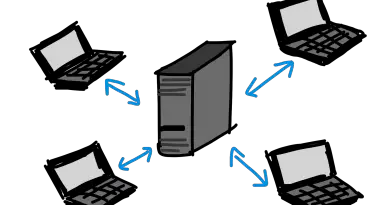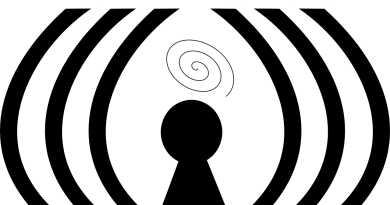What is Optical Fiber Cable and it’s Connectors
Till now we have already discussed the two wired transmission medium i.e. twisted pair and the coaxial cables used in the physical layer . Now in this post, we will understand the next important wired transmission medium i.e the optical fiber cables, and also see its connectors used with various of its applications.
A fiber optic cable is made of glass or plastic and transmits signals in the form of light. The construction of an optical fiber cable is as shown in the below figure.
What is Optical Fiber Cable (fiber optic cable definition) ?
Optical fiber cable generally has a cylindrical shape and consists of three concentric sections: the core , the cladding, and the jacket. It is basically based upon the principle of reflection which guide the light through a channel.
A glass or plastic core is surrounded by a cladding of less dense glass or plastic . The difference in the density of the two materials must be such that the beam of light moving through the core and is reflected off the cladding instead of being refracted into it.
It consists of an inner glass core surrounded by a glass cladding which has a lower refractive index and a protective covering. Digital signals are then transmitted in the form of an intensity-modulated light signal .
Light is launched into the fiber at one end using a light source such as a light-emitting diode (LED) or laser. It is detected on the other side using a photodetector such as a phototransistor or photodiode.
The optical fiber cables are costlier than the other two types but they have many advantages over the other two types (i.e. the twisted pair cables and the coaxial cable ).
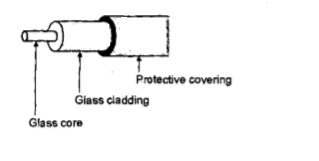
The outermost layer is the jacket . The jacket is composed of plastic and other material layered to protect against moisture , abrasion , crushing, and other environmental dangers.
For data transmission to take place, the sending device that is the transmitter must be capable of inducing data bits ‘0’ to ‘1’ into the light source. At the receiver a photodiode is used to translate, this light back into data bits .
The two light sources which are used popularly are :
LED (light-emitting diode) and the Injection laser diode (ILD) . The LED is cheaper but has a disadvantage that it provides an unfocused light that hits the core boundaries and gets diffused.
Working of Optical Fiber Cables
Optical fibers basically use the reflection to guide light through a channel. A glass or plastic core is surrounded by a cladding of less dense glass or plastic material. The difference in density of the two materials must be such that , any beam of light moving through the core is then reflected off the cladding instead of being refracted into it .
Principle of Light Propagation In a Fiber
The light enters into a glass fiber from one end and gets reflected within the fiber. It follows a zigzag path along the length of the fiber as shown in figure :
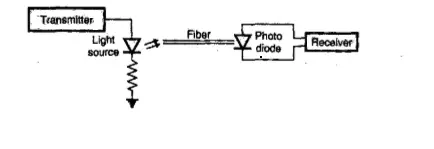
When the light enters into a glass fiber from one end, most of it propagates along the length of the fiber and comes out from the far end.
A small portion of the incident light escapes through the side walls of the fiber. The light which travels from one end to the other end of the glass fiber is said to have “guided” through the fiber.

The light stays inside the fiber and does not escape through the walls because of the “total internal reflection” taking place inside the fiber.
Modes of Propagation in Optical Fiber Cable
The number of paths followed by light rays inside the optical cable is called modes . Below figure shows different modes of operation of optical fiber :

There are two types namely single mode and multimode fibers. In single mode, light follows a single path through the core whereas, in multimode, the light takes more than one paths through the core.
Single Mode Optical Fibers :
Single-mode basically uses step-index fiber and a highly focused source of light that will limit beams to a small range of angles, all close to the horizontal. The single-mode fiber itself is manufactured with a much smaller diameter than that of the multimode fiber.
The optical signal traveling inside this fiber has only one group velocity . Due to single-mode travelling, the amount of dispersion is less than that introduced in multimode fibers.
These fibers can have either a step index or graded index profile. They are high-quality fibers used for wideband long haul communication and they are fabricated from doped silica to reduce internal attenuation.
Optical fibers are can also be defined by the ratio of the diameter (shown above) of their core to the diameter of their cladding, both expressed in the units of micrometers. The decrease in density further results in a critical angle that is close enough to 90° to make the propagation of beams almost horizontal.
The light travel in a single mode fiber , this beam travel’s almost horizontally and follows only one path from source to destination. The critical angle of incidence , a highly focused light beam is nearly equal to 90° .
In the single-mode fibers the delays are negligible and the signal reconstruction at the receiver is easier which results in almost no signal distortion.
Multimode Optical Fibers
In Multimode multiple beams from a light source move through the core in different paths. These are called multimode fibers because they support the simultaneous propagation of many modes and the incident light follows different paths from the source to destination.
In multimode step-index fiber, the density of the core normally remains constant from the center to the edges. A beam of the light moves through this constant density in a straight line until it reaches the specific interface of the core and the cladding.
At the interface, there will be an abrupt change due to the lower density, this alters the angle of the beam’s motion. The term step index mainly refers to the suddenness of this change, which contributes to the distortion of the signal as it passes through the fiber.
Each mode has its own group velocity and each mode will follow its own path while travelling, from the transmitter to receiver.Due to the presence of more than one modes, the intermodal dispersion will exist.
The second type of fiber, called multimode graded-index fiber, decreases this distortion of the signal through the cable. The word index typically refers to the index of refraction.

A graded index fiber, hence is the one with varying densities. Density is the highest at the center of the core and decreases gradually to its lowest at the edge. The impact of this variable density on the propagation of light beams .
Multimode fibers can have the step-index or graded index profile and they are fabricated using the multicomponent glasses or doped silica.
Characteristics of Optical Fiber Cables
1. Fiber optic cabling can provide extremely high bandwidths in the range from 100 Mbps to 2 Gbps because light has a much higher frequency than electricity.
2. The number of nodes that a fiber optic can support doesn’t depend on its length but on the hub or hubs that connect cables together.
3. Fiber optic cable has much lower attenuation and can carry the signal to longer distances without using amplifiers and repeaters in between.
4. Fiber optic cable is not affected by EMI effects and can be used in areas where high voltages are passing by.
5. The cost of fiber optic cable is more as compared to twisted pair and coaxial. The installation of the fiber optic cables is difficult and very tedious.
Advantages of Optical Fibers Cables
1. Small size and lightweight : The size (diameter) of the optical fibers is very small (it is comparable to the diameter of a human hair).
2. Easy availability and low cost : The material used for the manufacturing of optical fibers is “silica glass”. This material is easily available.
3. No electrical or electromagnetic interference : Since the transmission takes place in the form of light rays the signal is not affected due to any electrical or electromagnetic interference.
4. As the light rays generally have a very high frequency in the GHz range, the bandwidth of the optical fiber is extremely large.
5. No cross-talk inside the optical fiber cable , Intermediate amplifier is not required as the transmission losses in the fiber is low.
Fiber Optic Cable Connectors
Fiber optic cables use three types of connectors as shown in the figure. The types are :
- Subscriber channel (SC) connector
- Straight tip (ST) connector
- MT – RJ connector
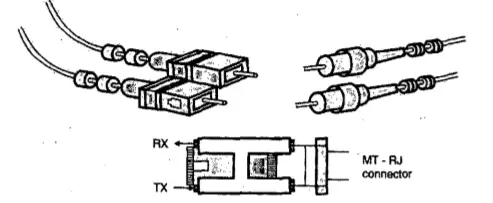
The SC connector is used for cable TV. It uses a push/pull locking system. The ST connector is used for connecting a cable to networking devices. It mainly uses a bayonet locking system and is more reliable than SC . MT-RJ is a new connector. It has the same size as RJ 45.
Applications of Optical Fiber Cables (Fiber Optic Cable Uses)
Fiber-optic cable is often found in the backbone networks because of its wide bandwidth is cost-effective.Some cable TV companies also use a combination of optical fiber and coaxial cable, thus creating a hybrid network.
Optical fiber provides the backbone structure while coaxial cable provides the connection to the user premises.Also used in the Local Area Networks (LANs )
Finally, we have reached the end of this post. Stay tuned for more interesting stuff in this series..

Aric is a tech enthusiast , who love to write about the tech related products and ‘How To’ blogs . IT Engineer by profession , right now working in the Automation field in a Software product company . The other hobbies includes singing , trekking and writing blogs .


